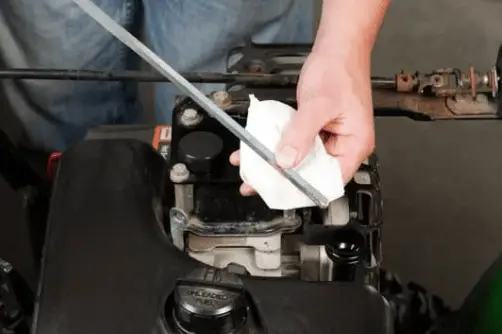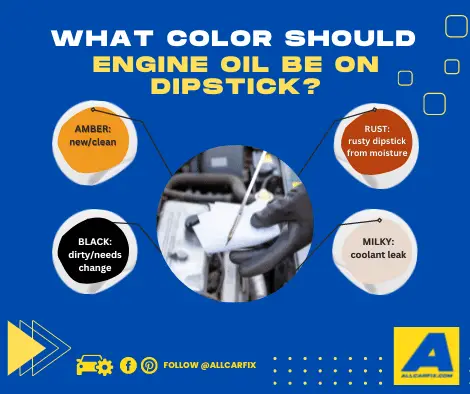After some time and mileage, your engine oil will appear considerably darker and dirtier. Eventually, you will have to drain and change your engine oil as part of your car’s basic routine maintenance. In this article, we are going to discuss what color should engine oil be on dipstick.

The first thing that you should do is pull out the dipstick and check its level and color. The color of the oil on the dipstick tells you whether the oil is clean or dirty. Depending on your car’s mileage since the last oil change, here’s what color engine oil should be on the dipstick:
What color should my oil be on the dipstick?
On your dipstick, engine oil can look in shades of amber, brown, or black, depending on the car's mileage or time since the last engine oil change. Clean engine oil should appear in hues of amber, while oil that needs to be replaced will appear a thick and dark shade of black.

As mentioned above, when something has to be replaced because it is old, it will appear considerably darker and dirtier. The oil may seem a little darker and could darken more quickly, depending on the additives you use. Nevertheless, depending on the oil being used, shades of colors can vary.
In some cases, it may appear milky and foamy, indicating moisture or coolant leaks in the engine. Another factor that can affect the color of the engine oil is the amount and types of additives depending on your engine oil’s brand.
Read more: Can You Mix Oil Brands? Top 6 Engine Oil Facts
As a result, a darker hue might not be problematic. However, it would help if you always took caution regarding your engine. Motor oil collects contamination-causing combustion by-products over time.
The fact that it gets darker confirms that it is functioning as intended.
Let’s discuss each engine oil color on your dipstick below:
What the color of your engine oil tells you?
1. Amber
It's typical for new or clean motor oil to be light amber in color. When you see light yellow or amber oil in your dipstick, your oil is clean and good to go for another 3000-5000 miles without changing.
But, this color may differ significantly based on the type of oil (synthetic or conventional) and the new oil’s chemicals (signature additives). For example, Signature Series Synthetic Motor Oil has a slight reddish tint due to its additives.

Here are some color variations and characteristics of new and clean engine oil:
- Translucent yellow
- Honey golden
- Light caramel
- Reddish brown
- Caramel
Read more: Clean vs Dirty Engine Oil Comparison
2. Dark Brown or Black
Dark oil often indicates that it has cycled throughout your engine too frequently and needs to be changed. It may be expected for engine oil to turn dark brown or black, or there may be a problem.
Remember that thin engine oil that is deeper in color does not necessarily mean that the oil is unclean. But if it is thick and dark, it may indicate soot build-up due to dirt or dust contaminants exposure and needs to be replaced.
Using oil with numerous chemicals and additives of different engine oil brands may also produce black crude.
3. Milky or Cream
If the oil seems milky and foamy, it indicates an oil issue with moisture. Typically head gasket leak that causes the cream-colored oil usually allows coolant to seep into the oil.
Some common signs of a leaking head gasket include:
- Leaking coolant under your car
- Low coolant level
- White smoke from the exhaust
If you don’t observe the other symptoms above, there is a slight chance that the creamy oil isn’t a head gasket rupture. Therefore, don’t put off getting the issue fixed, or you risk accruing even higher repair costs.
In some cases, if water accidentally contaminates the oil, you may change the oil, and the problem ought to go away.
4. Rust
The engine oil may change color to rust if your car is older or you reside in an overly humid area. This may result to condensation accumulation and cause rusting on the surface of the dipstick, giving the oil a rusty appearance.
In addition, there’s a risk of a flaw causing some automatic transmission fluid to seep into the engine. The combination may then have a rusty appearance. But it should be a warning that you must immediately take the car to the technician.
Note that some engine oils are reddish brown in color when they are new. Out-of-the-bottle, conventional engine oils are a red-brown amber color.
Advance Auto Parts
Read more: Is Synthetic Oil Better for High-Mileage Car? Benefits of Synthetic High-Mileage Oil
How to Inspect the Oil in Your Car
Step 1: Preparation
The vehicle must be parked and secured before you may do anything with it.
- Make sure your car is level, has the transmission in Park, has the parking brake engaged, and is parked there.
- To give the engine a chance to cool down, turn off the engine and wait a few minutes slightly. You are prepared to move forward once the engine has cooled down.
- Raise the hood. Read your owner’s handbook if you have questions about how to do this. The hood release lever is typically located behind the left instrument panel.
- When the engine is only slightly warm, you can check the oil level and quality, but you must be cautious where you touch it because the parts might still be hot.
Read more: Can You Add Oil While The Engine is Hot? Top 6 Questions
Step 2: Pull out the Dipstick
The dipstick usually is easy to identify since it has a little colored handle that is often orange or yellow and is inscribed with an oil-can emblem.
If you can’t locate it, search for an engine compartment map that details where everything is in the instruction booklet.
- Take the dipstick out.
- Ensure that none of the oil spills onto the motor because if it does after it gets hot, it will emit a burning smell.
- Hold a cloth or lint-free paper towel beneath it to prevent it from dripping.
Step 3: Check your Oil
- Clean the dipstick wipe with some paper towels or a cloth. Right now, all you need to do is clean the dipstick; you are not looking to check the levels.
- The stick is ready to be reinserted into the tube after being cleaned.
- Push the dipstick down into the tube while carefully inserting it.
- Take it out and attentively inspect the tip. Check the color of the oil on the dipstick carefully.
FAQs
What shade of oil needs to be on the dipstick?
New oil will typically be amber in color, whereas older oil will typically be darker. Engine oil’s color can vary depending on how long it has been inside and whether your car has issues, such as a coolant leak and rusty dipstick.
What color of motor oil is alarming?
The bad engine oil will have a different color depending on the situation. Frothy, creamy-colored oil could indicate water or coolant contamination, whereas milky-colored oil might indicate a head gasket leak.
What is the color of the used oil?
Used oil typically has a dark brown to black color or shade. When exposed to dirt or dust contaminants, engine oil can accumulates soot and turns black and thick in texture.
What does the browning of my oil imply?
Brown oil may indicate the start of oxidation or that you must change it since it has been circulated through the engine too frequently. If the oil hasn’t been in for very long, it may have contained numerous chemicals or additives, depending on the brand.
Key takeaways
There are various factors to bear in mind when examining the color of the oil, as mentioned above. Suppose you observe the engine oil changing to a darker color, which all engine oil will be eventually it means you need an oil change.
Aside from dark or black oil, you should watch out for milky or creamy oil on your dipstick, which may indicate a coolant leak.
The typical oil change period for current cars is between 5000 and 7000 miles or every three to six months, but it doesn’t mean you shouldn’t check for oil level and other replacement symptoms, such as oil color on the dipstick.
You don’t want to run on low or no oil on your car!
We hope this article has given you more knowledge about handling engine color changes.
Elevate your car maintenance game by reading our comprehensive guide on engine oil. Learn everything from the basics of oil types, to how to properly maintain and change it. Keep your vehicle running at its best, read our guide now!
